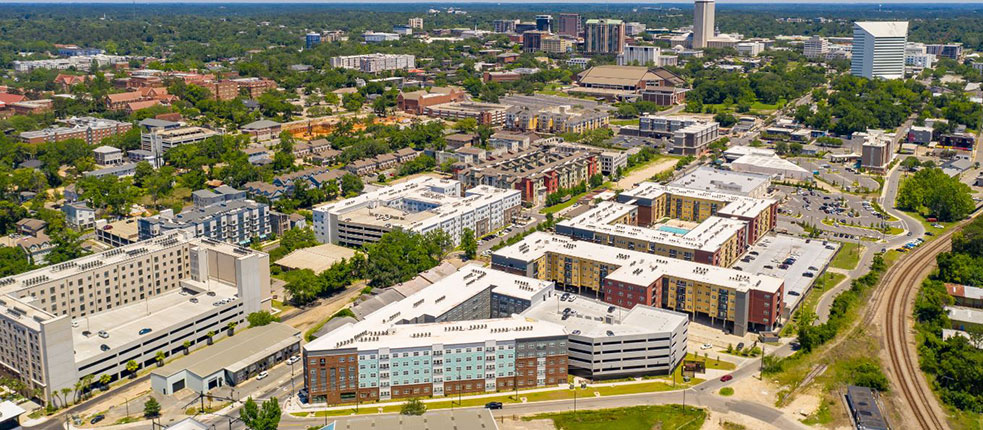

By Chris Bruen
Chris Bruen is the Director of Research at the National Multifamily Housing Council (NMHC) in Washington, D.C. He can be reached at cbruen@nmhc.org.
Student housing has long enjoyed the reputation of being an asset class that is more resilient in the face of economic uncertainty than some of its other real estate counterparts. However, as the COVID-19 pandemic shut down college campuses across the country and then led to a wide variety of reopening plans as a new academic year opened, investors have been curious as to what the full effect the pandemic has had on the market’s performance over the last year. Here’s a look at the data.
Sector Experiences Challenges During the Pandemic
During the first three months of 2020, off-campus student housing beds were leasing at a higher rate than in the prior year. However, with the onset of the pandemic in late March, preleasing activity for the next academic year decelerated drastically. Among a core 175 universities tracked by RealPage, just 87.0 percent of beds were preleased for the Fall semester by August of 2020, down 4.5 percentage points from the previous year. The Yardi 200 universities similarly posted a 5.5 percentage point decrease year over year in prelease occupancy, reaching just 88.7 by the Fall of 2020.
Furthermore, as in-person classes were put on hold and many campuses remained shut down, many students opted to delay their college plans. According to the National Student Clearinghouse, fall enrollment dropped 2.5 percent, accelerating longer-term rates of broad enrollment declines.
This weaker demand negatively affected occupancy rates. In-place occupancy fell to just 87.2 percent at RealPage’s core 175 universities by the fall, down 4.3 percentage points from the previous year.
These lower occupancy rates put a drag on rent growth, with rent growth continuing, but at a slower pace than pre-pandemic. But as more schools put in place reopening plans replete with new safety protocols and policies, rents began to slowly recover. Data from RealPage showed rents grew 0.2 percent year over year by December 2020, compared to 1.4 percent growth in December 2019. However, data from Yardi showed rents to be much more resilient throughout the pandemic, recording 1.4 percent year-over-year rent growth in December 2020, but still at a slower pace than the previous year.
Market Rebounds Quickly as Schools Reopen
While preleasing for the 2021-22 academic year also got off to a sluggish start—according to Yardi, just 29.5 percent of beds were preleased by December 2020, down 2.8 percentage points from the year prior—much of this pain was concentrated in expensive coastal markets. In their 1Q report , researchers from Yardi noted that many large public universities recorded significant year-over-year increases in their prelease rates at the end of 2020. Case in point were the University of New Hampshire-Main Campus (+25.6 percentage points), the University of Louisiana at Lafayette (+25.4 percentage points) and the University of Georgia (+24.5 percentage points).
Furthermore, as vaccination rates increase, COVID case numbers decrease and the economy continues to reopen, preleasing rates for the upcoming school year are also rapidly rising. The prelease rate among the RealPage 175 rose 9.4 percentage points in March 2021 and 9.6 percentage points in both April and in May, marking the three largest monthly increases since March of last year. Among the Yardi 200, preleasing increased 7.8 percentage points month over month to 58.6 percent in April, still down 4.2 percentage points from the year prior.
Investment activity in the sector seems to have rebounded as well. Sales volume in private student housing tracked by Real Capital Analytics dropped 90.0 percent to $153.2 million in 2Q 2020, the lowest level recorded in a decade. After the initial outbreak period, however, capital began to come off the sidelines, with volume increasing 156.5 percent in 3Q 2020 and then 1,015.9 percent over the following quarter to reach $4.4 billion in 4Q 2020. Only once, in 3Q 2018, has quarterly sales volume eclipsed this level of deal flow.
However, transaction volume then retreated from this elevated level to $0.9 billion in 1Q 2021, down 42.6 percent from the previous year. Cap rates, meanwhile, fell 10 bps to 5.3 percent in 1Q 2021, the second lowest on record, but offering a slight discount relative to the 5.0 percent cap rate offered in the conventional market.
Finally, fall enrollment decreased 2.5 percent in 2020, according to the National Student Clearinghouse, more than double the 1.3 percent decrease recorded in 2019. Yet, since enrollment growth has historically been unaffected by economic recessions, we can attribute this drop off in enrollment to the unique circumstances of the COVID-19 pandemic, which was a true black swan event. Furthermore, the National Student Clearinghouse recorded positive enrollment growth in 2020 among public four-year institutions (+0.2 percent)—driven by an uptick in graduate students—and among private for-profit four-year institutions (+5.3 percent).




